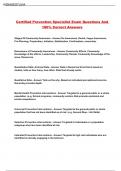AGRADESTUVIA
Certified Prevention Specialist Exam Questions And
100% Correct Answers
Stages Of Community Awareness - Answer No Awareness, Denial, Vague Awareness,
Pre-Planning, Preparation, Initiation, Stabilization, Confirmation, ownership.
Dimensions of Community Awareness - Answer Community Efforts, Community
Knowledge of the efforts, Leadership, Community Climate, Community Knowledge of the
issue, Resources.
Quantitative Data: Archival Data - Answer Data in Numerical form that is based on
studies, tells us how many, how often. Data that already exists.
Qualitative Data - Answer Tells us the why. Based on individual perceptions/concerns.
Generally provides depth.
Mental Health Promotion interventions - Answer Targeted to a general public or a whole
population. (e.g. School programs, community centers that promote emotional and
social competence)
Universal Preventive Interventions - Answer Targeted to the general public or whole
population that has not been identified as at risk. (e.g. Second Step - Life Skills)
Selective Preventive interventions - Answer Targeted to individuals or a population
subgroup who have been identified at risk
Indicated Preventive Interventions - Answer Targeted to high risk individuals who are
identified as already engaging in the behavior.
,AGRADESTUVIA
Six CSAP Prevention Strategies - Answer Information Dissemination, Prevention
Education (Skill Building), Alternatives (Positive Activities), Environmental Strategies,
Community Based Process, and Problem Identification and referral.
Information Dissemination - Answer Increased knowledge and attitude change about
substance use and abuse through such services as classroom discussion and media
campaigns.
Prevention Education (Skills Building) - Answer Teaches participants critical social
skills, such as drug resistance and decision making.
Alternatives (Positive Activities) - Answer Provide opportunities for participation in
developmentally appropriate drug-free activities to replace, reduce or eliminate
involvement in substance use related activities.
Environmental Strategies - Answer Prevention efforts aimed at changing or influencing
community conditions, standards, institutions, structures, systems and policies that
shape behaviors.
Community-Based Process - Answer expands community resources dedicated to
preventing substance use and abuse through services such as building coalitions.
Problems Identification and referral - Answer recognize individuals who have used
alcohol, tobacco, or drugs.
Agent - Answer Drug (alcohol, prescription, Illegal)
Host - Answer Individual
Environment - Answer Physical and social content
, AGRADESTUVIA
Context - Answer places, settings, occasions and circumstances in which behaviors
occur
Protective factors - Answer Anything that decreases the probability of developing
problematic substance abuse.
Social Development Strategy - Answer A research based model that organizes known
protective factors into a guiding framework for building positive futures for children.
S.M.A.R.T - Answer Specific, Measurable, Achievable, Relevant, Timed
SPF-Answer Assessment of Capacity, Planning, Implementation, And Evaluation all
working around a sustainable and Cultural competent center.
Individual Strategy - Answer Targets individuals - provides info, builds skills and
provides support
Community Strategy - Answer Changes in policies and laws that effect the whole
community and the norms, Regulations and availability of the risk factor
Individual outcomes - Answer Changes made on an individual level
Organizational outcomes- Changes made within an organization
System outcomes- Changes made in Multiple organizations- the whole thing is to be
changed
Implementation of Evidence- Based Programs- Answer Exploration, Installation, Initial
Implementation, Full Implementation and Program Sustainability
Communication-Answer The process of information transfer, and/or the exchange of
ideas, feelings, intentions, attitudes, expectations, perceptions or commands, through
verbs, actions, writings, behavior between two or more parties




